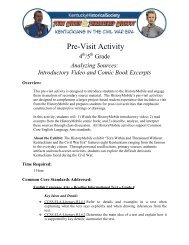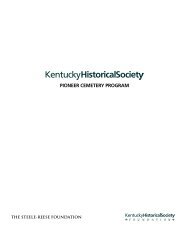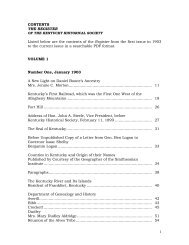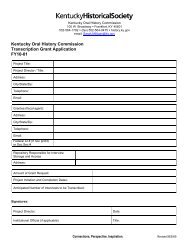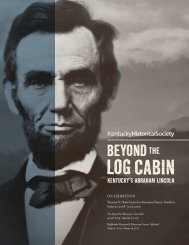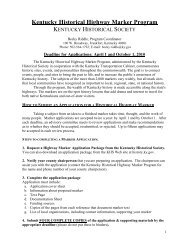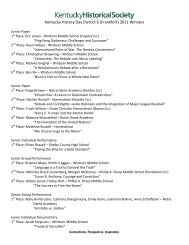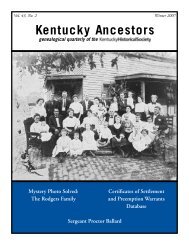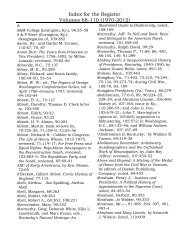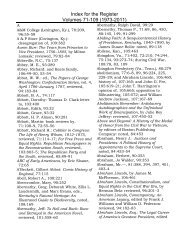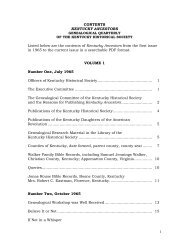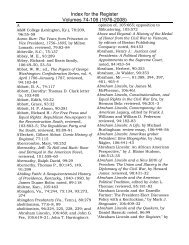Kentucky Ancestors, Volume 46, Number 1 - Kentucky Historical ...
Kentucky Ancestors, Volume 46, Number 1 - Kentucky Historical ...
Kentucky Ancestors, Volume 46, Number 1 - Kentucky Historical ...
You also want an ePaper? Increase the reach of your titles
YUMPU automatically turns print PDFs into web optimized ePapers that Google loves.
1831 tax ledger, his property was in Section 7, Range<br />
3, Henry County. 78<br />
The Tennessee General Assembly created civil<br />
districts within each of the existing counties in<br />
1836.79 Henry County was initially divided into<br />
sixteen districts. 80 Hogan’s property was in District<br />
No. 5. 81 An 1838 county map placed Civil District<br />
No. 5 in section 7, ranges 3 and 4; 82 it is west of Paris;<br />
its western boundary extends to the Weakley County<br />
line. 83 The Como community is in District No.<br />
5. 84 Hogan and his family members most probably<br />
encountered some of the Chickasaw hunting parties<br />
that frequently returned to the area in violation of the<br />
1818 treaty. 85<br />
Court records indicated that Hogan lived out the<br />
remainder of his life in Henry County.<br />
He was a witness in a civil suit in Henry County<br />
Circuit Court in 1826; 86 he vouched for the military<br />
service of Lewis Atkins when Atkins applied for<br />
a Revolutionary War pension in 1832; 87 he was a<br />
resident of Henry County when he applied for a<br />
Revolutionary War pension in September 1832; 88 he<br />
was on the Henry County voter registration rolls in<br />
1833; 89 he witnessed a deed between Nathan Parker<br />
and the heirs of Squire Reynolds of Stewart County,<br />
Tennessee, in July 1835; 90 he gave an affidavit for<br />
Abraham Newton when Newton applied for a<br />
Revolutionary pension in 1836; 91 he received his<br />
last Revolutionary War pension payment from the<br />
Jackson pension office in September 1837; 92 he<br />
wrote his last will and testament on 11 February<br />
1838; 93 he died in Henry County on 13 February<br />
1838; 94 and his estate was sold by his executor on 4<br />
June 1838. 95<br />
Edmond Hogan named his children in his will. 96<br />
He listed the eight oldest first and the seven youngest<br />
last. He listed his daughter, Polly Stoker, in both<br />
groups. The eight oldest were: John Hogan, James<br />
Hogan, Sally Hogan, Elizabeth Yarbrough, Edward<br />
Hogan, William Hogan, Agnis Stone (deceased), and<br />
Polly Stoker. The seven youngest included: Sintha<br />
Curlin, Polly Stoker, David Hogan, Nancy Hogan,<br />
Winney Hogan, Wilson R. Hogan, and Mathew R.<br />
Hogan. 97<br />
Edmond Hogan’s place of burial is unknown.<br />
He was most likely buried near his home. The grave<br />
roster for the Tennessee Society of the Daughters of<br />
the American Revolution indicates that he was buried<br />
in Henry County. 98 His lineage has been established<br />
with the NSDAR. 99<br />
Edmond Hogan is included in The Hogan DNA<br />
Project: y-Results Web site hosted by WorldFamilies.<br />
net. His genetic profile may be viewed at: http://<br />
www.worldfamilies.net/surnames/hogan/results/raw.<br />
Edmond Hogan led an adventurous life. He was<br />
a patriot in the American Revolution; he traveled<br />
about much of present-day <strong>Kentucky</strong>, Missouri, and<br />
Tennessee; he lived under the flags of Britain, Spain,<br />
France, and the United States, but according to one<br />
of his sons he had few worldly possessions. 100 He<br />
obviously placed little emphasis on material things.<br />
Estate records confirm that he had little real property,<br />
but a fair share of personal property. The sale bill for<br />
his belongings indicated that he owned a few farm<br />
implements, some tools, saddles, livestock, poultry,<br />
and a good amount of household items, including<br />
kitchenware, a lot of books, and a few pieces of<br />
furniture. 101 Edmond Hogan’s legacy, no doubt,<br />
included his Revolutionary War service, his westward<br />
exploits, and his free-spirited lifestyle.<br />
[Note: Researchers have confused Edmond<br />
Hogan with his cousin, General Edmund Hogan<br />
(ca.1780-1828), who served in the General Assembly<br />
of the Missouri Territory.] 102<br />
ENDNOTES<br />
1 Edmond Hogan, Revolutionary War pension file,<br />
no. S1671, http://persi.heritagequestonline.com<br />
(visited 8 July 2010).<br />
2 James Hogan will (1793), Anson County, North<br />
Carolina, will book A:22; a copy of the will is at the<br />
North Carolina State Archives, Raleigh, North<br />
Carolina; abstract in May Wilson McBee, Anson<br />
County, North Carolina, Abstracts of Early Records<br />
(Greenwood, Miss., 1950): 1:123.<br />
3 Edmond Hogan, Revolutionary War Pension file, no.<br />
S1671.<br />
4 Ibid.<br />
5 “Tennessee Pension Roll,” The Pension Roll of 1835,<br />
The Southern States (1835; reprint, Baltimore, 1968),<br />
3:70.<br />
6 Edmond Hogan, Revolutionary War Pension file, no.<br />
S1671.<br />
Autumn 2010 | 21



